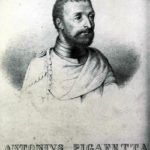The waters surrounding us hold the key to who we are
The migratory patterns and movements of the Austronesians across Asia and the Pacific explain why we have so many cultural similarities like 'art styles, rituals, traditions, physical features, language, and even tattooing practices' with Austronesia.
I was on a small island in Garchitorena, Camarines Sur a few years back. The island had a small number of inhabitants—fisherfolks mostly, who earn their living from the sea. I would often visit the island as a child and I still do visit, but not nearly as often anymore.
During one of my visits, I remember seeing some fishermen hulling out a tree trunk. I was fascinated. It looked too simple (big enough to hold only one person or two) to navigate the big body of water surrounding the island, but the men working on the boat assured me it would float.
This simple vessel called canoa or canoe was mentioned in Mazimilianus Trnsulvanusa book, De Moluccis Insulis or Of the Moluccas Islands, a compilation of accounts from survivors of the Magellan-Elcano expedition. It is the first known book (originally in letter form from Mazimilianus to the Cardinal of Salzburg) written in 1522 and published in France in 1523, mentioning the expedition to the Philippines.

The Magellan-Elcano expedition left Spain in 1519 and returned in 1522. Its goal was to find a western maritime route to the Spice Islands, now known as Malacca in Indonesia. Along the way, the expedition chanced upon the islands we now call the Philippines. If you recall, the Treaty of Tordesillas (1494) divided the New World between the two maritime superpowers then: Portugal and Spain. Portugal was to control the trade routes in the eastern hemisphere and Spain was to do the same with the trade routes in the western hemisphere.
Magellan had to find a route to the Spice Island via the Americas passing through the Atlantic and the Pacific Oceans since Portugal was given control over the eastern trade routes through the Cape of Good Hope and the Indian Ocean.
The Magellan-Elcano expedition led by Ferdinand Magellan, departed Spain in 1519, taking off from San Lucar in the Cadiz Province, Andalusia in Southern Spain. From the original five-ship armada (Trinidad, Santiago, Victoria, Concepcion, and San Antonio), which collectively carried a 270-strong contingent, only the Victoria managed to return to Spain on Sept. 6, 1522 with 18 Europeans and a crew of three Moluccans. This feat made the returning expedition captain Juan Sebastián Elcano and his crew the first to have circumnavigated the earth.
Magellan perished in the Battle of Mactan on April 27, 1521 in the Philippines and while the Treaty of Tordesillas divided the trading routes between Spain and Portugal, Elcano, after finally reaching the Spice Islands, decided to return to Spain via the Portuguese trade route around Africa because by doing so, he wrote to his King, “They were going to do what could be narrated,” meaning it would be something to be talked about and remembered as the first to circumnavigate the globe. Among those who returned was an Italian scholar named Antonio Pigafetta (1491-1534).

Aside from the De Moluccis Insulis, Pigafetta’s first-hand account of the journey, which he called, The First Voyage Around the World, has become a key source of information about the islands and its inhabitants at the point of Spanish contact.
Travel by sea and the spread of culture and spheres of influence are nothing new to the Filipinos. In an attempt to explain the growth of the population of the Philippines and the peopling of island and mainland Southeast Asia and the Pacific during prehistoric times, Australian National University professor for Archaeology and Anthropology proposed the Austronesian Expansion Theory or the Austronesian Migration Theory, which suggests a sea-borne migration.
“Austronesians traveled into the Pacific 6,000 years ago from the Chinese Mainland,” he said, adding that, based on archeological, botanical, zoological, ceramic, and linguistic evidence among others, from China they spread to areas in and around China about 3,500 years ago and after about 500 years they managed to reach the Philippines.
Austronesians are defined as, “a large group of people sometimes referred to as Austronesian-speaking peoples, found in Austronesia the area covering Taiwan, Island Southeast Asia (Brunei, Indonesia, Malaysia, the Philippines, Singapore, and East Timor), parts of Mainland Southeast Asia (Cambodia, Laos, Myanmar, Thailand, Vietnam, and Peninsular Malaysia), Micronesia (Caroline islands, Gilbert islands, Mariana Islands, and the Martial Islands), coastal New Guinea, Island Melanesia (Fiji, Vanuatu, Solomon Islands, Papua New Guinea, New Caledonia, and the Torres Strait Islands), Polynesia, and Madagascar off the coast of East Africa,. that speak Austronesian languages.” They were a maritime people and used the seas and oceans for travel, migration, and trade.

Bellwood adds that, from the Philippines, “Many Austronesians continued their travels, reaching Sumatra and Java by 2,000 BC, Northern New Guinea by 1,600 BC, Samoa by 1,200 BC, and Easter Island, Hawaii and Madagascar by 500 AD. Advancement in maritime technologies, from the simple canoe (dugged-out from a tree trunk) to the addition of the outrigger or katig or kate (a projecting beam running out from a ship’s main structure to provide additional stability or to support something), “catamaran (a double hulled watercraft), tanja sail (tilted sail), and the crab claw sail (a triangular sail), allowed Austronesians to go the distances and further.
The Austronesians, who decided to settle in the Philippines, serve as the foundation of the population of its inhabitants today, Bellwood says. The migratory patterns and movements of the Austronesians across Asia and the Pacific explain why we have so many cultural similarities like “art styles, rituals, traditions, physical features, language, and even tattooing practices” with Austronesia.
At present, records show that of the languages spoken in the Philippines, 87 are still Austronesian languages.